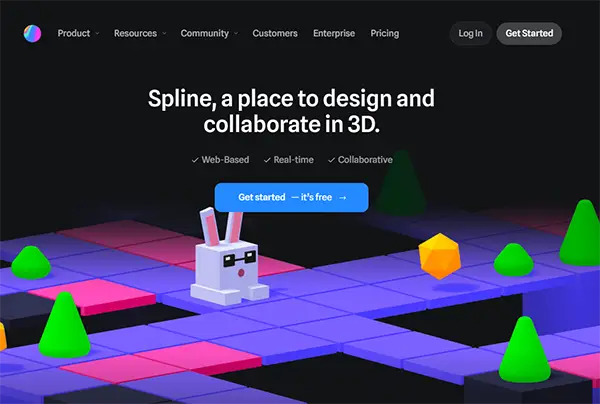Spline Ai 3D Tool

Ever wanted to dive into 3D design without feeling overwhelmed? Spline is an intuitive browser-based 3D design tool that makes interactive 3D creation easy, even if you’re a beginner. No coding skills? No problem – Spline’s no-code approach lets you build and play with 3D objects and animations visually. It’s a playground for UI/UX designers, developers, and creative folks who want to add a splash of 3D to their projects without the usual headache. Spline even comes with AI-assisted tools, so you can conjure up 3D assets or textures with simple prompts (like having a creative assistant in the app).
Plus, designing with your team is a breeze thanks to real-time collaboration features. When you’re ready to share your work, Spline’s seamless web integration means you can embed your interactive 3D scene on a website or export it in a snap.
Key Features
- Real-time collaboration – Co-create and edit 3D scenes live with your team in the browser.
- AI-assisted design – Generate 3D objects or textures using simple text prompts (a big creativity boost).
- No-code interactivity – Add animations and interactive mouse/touch events to your design without writing code.
- Easy 3D modeling – Start from basic shapes or templates and craft models with an intuitive interface.
- Materials & textures – Tweak colors and lighting and apply textures (even AI-generated ones) easily.
- Seamless embedding – Copy-paste a snippet to embed your 3D creation on any webpage or in your app.
Pros and Cons
| Pros | Cons |
|---|---|
| Beginner-friendly, intuitive interface (no coding needed) | Not ideal for very complex, high-detail 3D modeling |
| Real-time collaboration and AI tools spark creativity | Heavy scenes can tax your browser (performance may suffer) |
Spline Pricing
- Free – $0/month, unlimited personal files & viewers, web exports include a Spline logo.
- Starter – $15/month (or $12/month billed yearly); 2 editors, no Spline logo on exports, plus video imports and asset library.
- Professional – $25/month (or $20/month billed yearly); unlimited editors, code & mobile exports, and version history.
- Team—$36 per seat/month (billed yearly); includes everything in Pro plus team project folders and extra AI credits for the Spline AI add-on.
Spline Tutorial
- Open Spline: Visit Spline‘s website and create a new 3D project (sign up if you haven’t already).
- Add a shape: Use the toolbar to insert a basic 3D shape (like a cube or sphere) into the scene.
- Customize it: Use Spline’s tools to move or rotate the shape, resize it, and change its color or material.
- Export or share: Once you’re happy with your design, click the Export/Publish option. You can download an image or 3D file or copy an embed code to share your interactive scene on the web.
Spline Review
Spline’s most significant win is how it makes 3D design approachable for everyone. The interface is friendly, and no coding is required, so you can whip up something impressive without breaking a sweat. It’s convenient for teams — real-time collaboration and one-click embedding make adding interactive visuals to web projects a breeze. It won’t replace advanced 3D software for high-end animation or game development. Still, for prototyping, fun web interactions, and bringing everyday design ideas to life in 3D, Spline is spot on.
Is Spline free to use?
Yes – Spline offers a free plan that gives you access to core features and lets you create unlimited personal projects.
Do I need to know coding to use Spline?
Not at all. Spline is a no-code tool, so you can build interactive 3D scenes entirely through its visual interface.
How can I share or embed my 3D designs?
Spline lets you publish your scene and provides a link or embed code. You can embed the 3D design on a webpage or share the link directly, and you can also export your work to standard 3D file formats or images.
Can multiple people collaborate in Spline?
Yes. You can invite team members to your project, and everyone can work together in real-time on the same scene—just like Google Docs but for 3D.
What is Spline’s AI feature?
Spline’s optional AI add-on lets you generate 3D objects or textures from text prompts, helping you create assets faster (for example, type “wooden table” and watch Spline generate a 3D table for you).
what is a spline in 3d modeling?
In 3D modeling, a spline is a smooth, flexible curve defined by mathematical equations or control points. It is used to create and manipulate curved shapes and surfaces in a precise yet easily adjustable way.
How Splines Work in 3D Modeling
- A spline is made up of control points that determine its shape.
- Unlike straight lines, splines smoothly interpolate between points, allowing for organic and flowing designs.
- They can be used for modeling curved objects, like car bodies, animated character rigging, or even typography in 3D.
- Some common types of splines include Bézier curves, NURBS (Non-Uniform Rational B-Splines), and B-splines.
Where Splines Are Used
- Character animation – To create smooth motion paths for objects or camera movements.
- Industrial design & CAD – Used in engineering and product design for precision modeling.
- 3D graphics & animation – Helps in sculpting surfaces and creating fluid shapes.
- Game development – To design racing tracks, terrain paths, or animation paths.
Why Are Splines Important?
Splines offer precision, smoothness, and flexibility in 3D design, making them essential for crafting complex shapes with accuracy. Whether in 3D animation, product design, or game development, splines help artists and designers create more natural, organic forms that would be difficult to achieve with only straight lines and polygons.
what is spline 3d?
Spline 3D refers to a technique in 3D modeling and animation that uses mathematically defined curves (splines) to create smooth and flexible shapes. Instead of relying solely on straight lines and rigid polygons, splines allow designers to craft organic, flowing forms with precision and ease.


